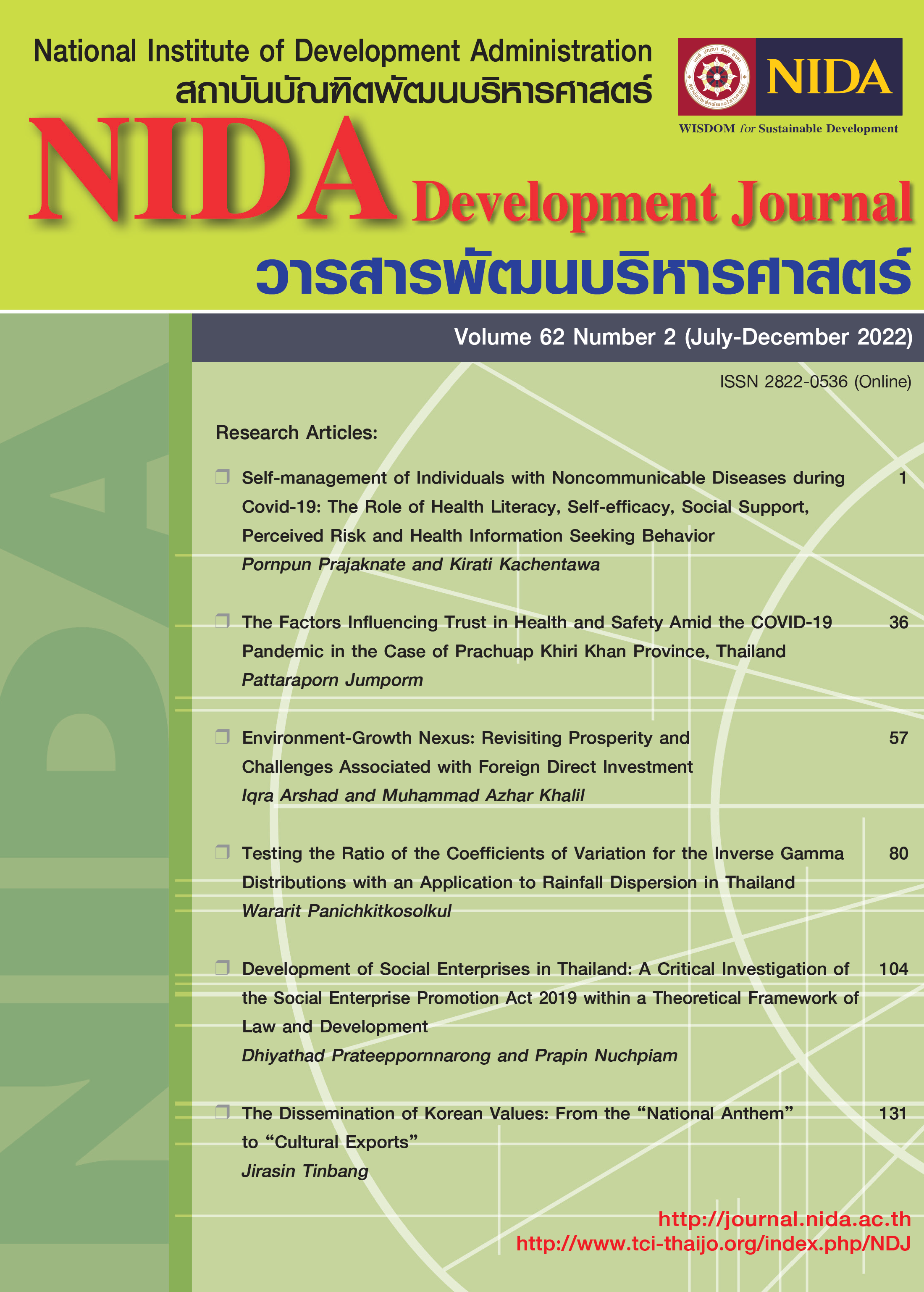Environment-Growth Nexus: Revisiting Prosperity and Challenges Associated with Foreign Direct Investment
Keywords:
Economic growth; Foreign direct investment; Carbon emission; Environmental PolicyAbstract
In this study, we develop a model to investigate the interactions between foreign direct investment (FDI), carbon emission (CO2), fixed capital accumulation (FCA), and economic growth by analyzing the sample from one of the emerging economies in Asia i.e., Pakistan during 1970 – 2017. In particular, the study examines the impact of FDI on both economic growth and environmental degradation. Using Ordinary Least Square and Johansen Juselius Co-integration approach, we observed that all the explanatory variables (i.e., FDI, CO2, and FCA) are positively related to the gross domestic product (GDP). Further analysis confirmed the widely accepted belief that FDI positively and significantly contributes to economic growth. However, such economic prosperity is generated at the cost of the environment, as the results show that FDI fosters the current level of CO2 which in turn poses a substantial challenge to the environmental quality. We offer a set of policies that policymakers should consider in Pakistan's environmental protection policy plan to combat environmental degradation and emissions.
References
Adu, D. T., & Denkyirah, E. K. (2017). Economic growth and environmental pollution in West Africa: Testing the Environmental Kuznets Curve hypothesis.
Ahmad, M., Jiang, P., Murshed, M., Shehzad, K., Akram, R., Cui, L., & Khan, Z. (2021). Modelling the dynamic linkages between eco-innovation, urbanization, economic growth and ecological footprints for G7 countries: does financial globalization matter? Sustainable Cities and Society, 70, 102881.
Ahmed, K., & Long, W. (2012). Environmental Kuznets curve and Pakistan: an empirical analysis. Procedia Economics and Finance, 1, 4–13.
Ahmed, Z., Zafar, M. W., & Mansoor, S. (2020). Analyzing the linkage between military spending, economic growth, and ecological footprint in Pakistan: evidence from cointegration and bootstrap causality. Environmental Science and Pollution Research, 27(33), 41551–41567.
Alam, M. J., Begum, I. A., Buysse, J., & Van Huylenbroeck, G. (2012). Energy consumption, carbon emissions and economic growth nexus in Bangladesh: Cointegration and dynamic causality analysis. Energy Policy, 45, 217–225.
Alfaro, L., Chanda, A., Kalemli-Ozcan, S., & Sayek, S. (2010). Does foreign direct investment promote growth? Exploring the role of financial markets on linkages. Journal of Development Economics, 91(2), 242–256.
Arcelus, F. J., & Arocena, P. (2005). Productivity differences across OECD countries in the presence of environmental constraints. Journal of the Operational Research Society, 56(12), 1352–1362.
Attari, M. I. J., Kamal, Y., & Attaria, S. N. (2011). The causal link between foreign direct investment (FDI) and economic growth in Pakistan economy. The Journal of Commerce, 3(4), 61.
Bandyopadhyay, A., & Rej, S. (2021). Can nuclear energy fuel an environmentally sustainable economic growth? Revisiting the EKC hypothesis for India. Environmental Science and Pollution Research, 28(44), 63065–63086.
Banerjee, S., & Murshed, M. (2020). Do emissions implied in net export validate the pollution haven conjecture? Analysis of G7 and BRICS countries. International Journal of Sustainable Economy, 12(3), 297–319.
Boyd, G. A., & McClelland, J. D. (1999). The impact of environmental constraints on productivity improvement in integrated paper plants. Journal of Environmental Economics and Management, 38(2), 121–142.
Cole, M. A., & Elliott, R. J. R. (2003). Determining the trade–environment composition effect: the role of capital, labor and environmental regulations. Journal of Environmental Economics and Management, 46(3), 363–383.
Copeland, B. R., & Taylor, M. S. (1994). North-South trade and the environment. The Quarterly Journal of Economics, 109(3), 755–787.
Desbordes, R. (2010). Global and diplomatic political risks and foreign direct investment. Economics & Politics, 22(1), 92–125.
Dickey, D. A., & Fuller, W. A. (1979). Distribution of the estimators for autoregressive time series with a unit root. Journal of the American Statistical Association, 74(366a), 427–431.
Eckstein, D., Künzel, V., & Schäfer, L. (2017). Global climate risk index 2018. Germanwatch, Bonn.
Faruku, A. Z., Asare, B. K., Yakubu, M., & Shehu, L. (2011). Causality analysis of the impact of foreign direct investment on GDP in Nigeria. Nigerian Journal of Basic and Applied Sciences, 19(1).
Govindaraju, V. G. R. C., & Tang, C. F. (2013). The dynamic links between CO2 emissions, economic growth and coal consumption in China and India. Applied Energy, 104, 310–318.
Granger, C. W. J. (1969). Investigating causal relations by econometric models and cross-spectral methods. Econometrica: Journal of the Econometric Society, 424–438.
Grossman, G. M., & Krueger, A. B. (1991). Environmental impacts of a North American free trade agreement. National Bureau of economic research Cambridge, Mass., USA.
He, Y., & Lin, B. (2019). Investigating environmental Kuznets curve from an energy intensity perspective: empirical evidence from China. Journal of Cleaner Production, 234, 1013–1022.
Husain, I. (2009). The role of politics in Pakistan’s Economy. Journal of International Affairs, 63(1), 1–18.
Jalil, A., & Mahmud, S. F. (2009). Environment Kuznets curve for CO2 emissions: a cointegration analysis for China. Energy Policy, 37(12), 5167–5172.
Johansen, S., & Juselius, K. (1990). Maximum likelihood estimation and inference on cointegration—with appucations to the demand for money. Oxford Bulletin of Economics and Statistics, 52(2), 169–210.
Jorgenson, D. W., & Wilcoxen, P. J. (1990). Environmental regulation and US economic growth. The Rand Journal of Economics, 314–340.
Jorgenson, D. W., & Wilcoxen, P. J. (2018). Environmental regulation and US economic growth. In Economic Costs and Consequences of Environmental Regulation (pp. 225–252). Taylor and Francis.
Kalim, R. (2001). Capital intensity in the large-scale manufacturing of Pakistan. Pakistan Economic and Social Review, 135–151.
Katrakilidis, C., Kyritsis, I., & Patsika, V. (2016). The dynamic linkages between economic growth, environmental quality and health in Greece. Applied Economics Letters, 23(3), 217–221.
Khan, A., & Kim, Y.-H. (1999). Foreign direct investment in Pakistan: policy issues and operational implications.
Lee, J., Lapira, E., Bagheri, B., & Kao, H. (2013). Recent advances and trends in predictive manufacturing systems in big data environment. Manufacturing Letters, 1(1), 38–41.
Letchumanan, R., & Kodama, F. (2000). Reconciling the conflict between thepollution-haven’hypothesis and an emerging trajectory of international technology transfer. Research Policy, 29(1), 59–79.
Li, J., Hu, Z., Shi, V., & Wang, Q. (2021). Manufacturer’s encroachment strategy with substitutable green products. International Journal of Production Economics, 235, 108102.
Liu, Jingkuang, Yi, Y., & Wang, X. (2020). Exploring factors influencing construction waste reduction: a structural equation modeling approach. Journal of Cleaner Production, 276, 123185.
Liu, Jinyu, Murshed, M., Chen, F., Shahbaz, M., Kirikkaleli, D., & Khan, Z. (2021). An empirical analysis of the household consumption-induced carbon emissions in China. Sustainable Production and Consumption, 26, 943–957.
Maxwell, J. W. (1996). What to do when win-win won’t work: Environmental strategies for costly regulation. Business Horizons, 39(5), 60–64.
Mikayilov, J. I., Galeotti, M., & Hasanov, F. J. (2018). The impact of economic growth on CO2 emissions in Azerbaijan. Journal of Cleaner Production, 197, 1558–1572.
Mrabet, Z., & Alsamara, M. (2017). Testing the Kuznets Curve hypothesis for Qatar: A comparison between carbon dioxide and ecological footprint. Renewable and Sustainable Energy Reviews, 70, 1366–1375.
Murshed, M. (2020). An empirical analysis of the non-linear impacts of ICT-trade openness on renewable energy transition, energy efficiency, clean cooking fuel access and environmental sustainability in South Asia. Environmental Science and Pollution Research, 27(29), 36254–36281.
Murshed, M., Ali, S. R., & Banerjee, S. (2021). Consumption of liquefied petroleum gas and the EKC hypothesis in South Asia: evidence from cross-sectionally dependent heterogeneous panel data with structural breaks. Energy, Ecology and Environment, 6(4), 353–377.
Murshed, M., Elheddad, M., Ahmed, R., Bassim, M., & Than, E. T. (2021). Foreign direct investments, renewable electricity output, and ecological footprints: do financial globalization facilitate renewable energy transition and environmental welfare in Bangladesh? Asia-Pacific Financial Markets, 1–46.
Murshed, M., Haseeb, M., & Alam, M. (2021). The Environmental Kuznets Curve hypothesis for carbon and ecological footprints in South Asia: the role of renewable energy. GeoJournal, 1–28.
Murshed, M., Rahman, M., Alam, M. S., Ahmad, P., & Dagar, V. (2021). The nexus between environmental regulations, economic growth, and environmental sustainability: linking environmental patents to ecological footprint reduction in South Asia. Environmental Science and Pollution Research, 28(36), 49967–49988.
Musatti, A., Ficara, E., Mapelli, C., Sambusiti, C., & Rollini, M. (2017). Use of solid digestate for lignocellulolytic enzymes production through submerged fungal fermentation. Journal of Environmental Management, 199, 1–6.
Nasir, M. A., Huynh, T. L. D., & Tram, H. T. X. (2019). Role of financial development, economic growth & foreign direct investment in driving climate change: A case of emerging ASEAN. Journal of Environmental Management, 242, 131–141.
Nathaniel, S. P., Murshed, M., & Bassim, M. (2021). The nexus between economic growth, energy use, international trade and ecological footprints: the role of environmental regulations in N11 countries. Energy, Ecology and Environment, 6(6), 496–512.
Ndikumana, L., & Verick, S. (2008). The linkages between FDI and domestic investment: Unravelling the developmental impact of foreign investment in Sub‐Saharan Africa. Development Policy Review, 26(6), 713–726.
Omisakin, D., & Olusegun, A. (2009). Economic growth and environmental quality in Nigeria: does environmental Kuznets curve hypothesis hold? Environmental Research Journal, 3(1), 14–18.
Panayotou, T. (2016). Economic growth and the environment. The Environment in Anthropology, 24, 140–148.
Peng, X., Liu, Z., & Jiang, D. (2021). A review of multiphase energy conversion in wind power generation. Renewable and Sustainable Energy Reviews, 147, 111172.
Rehman, A., Ulucak, R., Murshed, M., Ma, H., & Isik, C. (2021). An asymmetric analysis of the impacts of forests, livestock and economic progress on CO2 emissions in China. J Environ Manag, 294, 113059.
Rehman, M. U., & Rashid, M. (2017). Energy consumption to environmental degradation, the growth appetite in SAARC nations. Renewable Energy, 111, 284–294.
Richmond, A. K., & Kaufmann, R. K. (2006). Is there a turning point in the relationship between income and energy use and/or carbon emissions? Ecological Economics, 56(2), 176–189.
Shahbaz, M., Nasreen, S., Abbas, F., & Anis, O. (2015). Does foreign direct investment impede environmental quality in high-, middle-, and low-income countries? Energy Economics, 51, 275–287.
Tahvonen, O., & Kuuluvainen, J. (1993). Economic growth, pollution, and renewable resources. Journal of Environmental Economics and Management, 24(2), 101–118.
Varian, H. R. (1992). Microeconomic analysis (Issue 338.5 V299m 1992). WW Norton.
Wang, M. (2018). A Granger causality analysis between the GDP and CO2 emissions of major emitters and implications for international climate governance. Chinese Journal of Urban and Environmental Studies, 6(01), 1850004.
Wu, B., Jin, C., Monfort, A., & Hua, D. (2021). Generous charity to preserve green image? Exploring linkage between strategic donations and environmental misconduct. Journal of Business Research, 131, 839–850.
Xue, L., Haseeb, M., Mahmood, H., Alkhateeb, T. T. Y., & Murshed, M. (2021). Renewable energy use and ecological footprints mitigation: evidence from selected South Asian economies. Sustainability, 13(4), 1613.
Yu, B. (2021). Urban spatial structure and total-factor energy efficiency in Chinese provinces. Ecological Indicators, 126, 107662.
Zahir, S., Hayat, K., & Haider, A. (2020). The Causality between Gross Fixed Capital Formation, Trade Deficit, Exchange Rate, and the Economic Growth of Pakistan. International Review of Management and Business Research, 09(04), 138–147. https://irmbrjournal.com/papers/1607856111.pdf
Zambrano-Monserrate, M. A., Silva-Zambrano, C. A., Davalos-Penafiel, J. L., Zambrano-Monserrate, A., & Ruano, M. A. (2018). Testing environmental Kuznets curve hypothesis in Peru: The role of renewable electricity, petroleum and dry natural gas. Renewable and Sustainable Energy Reviews, 82, 4170–4178.
Zeraibi, A., Balsalobre-Lorente, D., & Murshed, M. (2021). The influences of renewable electricity generation, technological innovation, financial development, and economic growth on ecological footprints in ASEAN-5 countries. Environmental Science and Pollution Research, 28(37), 51003–51021.
Zhao, X., Gu, B., Gao, F., & Chen, S. (2020). Matching model of energy supply and demand of the integrated energy system in coastal areas. Journal of Coastal Research, 103(SI), 983–989.
Zhu, L., Hao, Y., Lu, Z.-N., Wu, H., & Ran, Q. (2019). Do economic activities cause air pollution? Evidence from China’s major cities. Sustainable Cities and Society, 49, 101593.
Zahir, S., Hayat, K., & Haider, A. (2020). The Causality between Gross Fixed Capital Formation, Trade Deficit, Exchange Rate, and the Economic Growth of Pakistan. International Review of Management and Business Research, 09(04), 138–147. https://irmbrjournal.com/papers/1607856111.pdf
Downloads
Published
How to Cite
Issue
Section
License
Copyright (c) 2022 NIDA Development Journal

This work is licensed under a Creative Commons Attribution-NonCommercial-NoDerivatives 4.0 International License.





